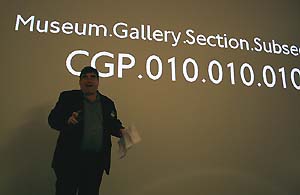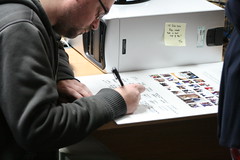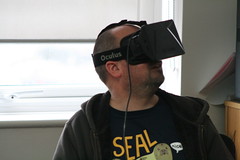It was up there on the screen – a neat but cryptic row of numbers and zeros – but the meaning of the moment dawned quickly.
Rob Lansdown of the London Transport Museum outlined how they’d gone back to basics trying to classify and manage info in their museum.
Rob’s really fascinating and forensically detailed tour through the digital history of the LTM kicked off the autumn 2008 meeting of the Museums Computer Group.
A packed day began with the background to the technological renaissance of the host museum; rebuilt physically too, the conceptual core of the institution has been taken apart and appended, sorted and re-assembled in ways that help understanding, creativity, and curation.
It’s interesting, too, that (software engineers) System Simulation, nearby in Covent Garden, have been fellow digital travellers with the museum since the mid ‘Eighties, developing with LTM all sorts of projects that were often first in the museum sector.
Opening the day, museum Director Sam Mullins welcomed Museums Computer Group members, explaining some of the big statistics of the place and the massive rebuild. Listening to Sam it sounded like the museum was a bit like the Forth Bridge, always in some sort of transition or remodelling; an impression that built even more as Rob Lansdown revealed the most recent reworking of the site seemed to begin just as the previous rebuild was opened.
After Rob Lansdown’s talk, Dylan Edgar opened out some issues revealed by the recent audience survey commissioned by the London Museums Hub. Here were some crucially interesting numbers: according to the work, most web visitors (who responded to the survey) to museum sites were looking for basic information about museums so they could make a visit. The second most numerous category were people looking for information about collection objects or items in the museum – the classic ‘long tail’ enquiry. User Generated Content was very low on the list of searched for content types. Relatively few teachers were using the sites. Food for thought for many in the room.
The Museums Computer Group holds an AGM every year, and acting MCG chair Ross Parry was confirmed as the new Chair during the meeting. Ross took the opportunity to thank Debbie Richards, standing down as Chair, for her sterling service over the last few years.
MCG membership secretary John Williams then presided over the voting in of a host of new committee members. It’s quite an exciting time to join the group, with all sorts of changes in the pipeline; so much so that we haven’t allotted any functions or titles to our new committee people. It’s likely that a new broom will sweep through and we’ll be a different shaped organisation as next spring turns to summer.
Quick and informal databursts folllowed lunch: Bryan Wills of the LTM outlined the thoughtful way the museum has brought UGC to life; James Watson of the National Maritime Museum showed their fab Flickr Commons work and Vicky Mitchell from the Yorkshire Museums Hub showed neat new mapping extensions of the MyLearning/MyYorkshire web sites.
Giles Carey, Project Officer from Exploring Surrey’s Past solicited feedback for their new site; James Schollar (University of Reading) related experiences with IT information systems for visitors to the Weald and Downland Museum; and Nick Poole of the Collections Trust rounded off the databursts with a really interesting glimpse into the developing partnership with Culture24.
This is all about coming up with digital strategies that lead the whole sector forwards in responsive, open ways. Look out for the blog on the Collections Trust website – the tone is set by the title: Open Culture.
The day began with Rob Lansdown explaining a reductive approach to information organisation; in other words, think clearly and carefully what there is to be sorted and named, and find a way to label everything, so it can be found by others, which – of course – is kind of what we’re all here for.
Our formal meeting moment ended with Clare Sussums, Head of Information Resources at the Museum of London, outlining new work she’s produced to help museums set up information policy, much in the way Rob and his colleagues have done. Clare’s work seeks to put together templates to guide museum staff along the way to clarity.
Could it be that there’s now a current flowing through the cultural sector towards better knowledge management and information strategy? It’s got to be a good thing. Every day there’s more written about our new world of cloud computing, unique resource identifiers, a more systematic ontological landscape and most importantly – the machine readable internet.
All of those connecting, sortable, relational and potentially infinite digital things need a more ordered real world to make any sense. So the chaotic museum, composed of haphazardly accumulated resources and collections, stored in legacy digital systems that don’t connect, supervised by human beings who can just about remember where some of it all came from (and how much it cost…); that museum needs to stop spending money on digitisation.
To me, instead, it should spend it on thinking, organisation of thought, the sociology of thought, the forensics of thinking, and even the art of thinking. To participate in the next wave of the web, culture organisations need to get the human/organisation/collection/inventory interface sorted. It’s not rocket science – Sainsbury’s/Tesco/Comet/Toyota/etc have been doing it for 100 years plus.
Lots more pics of the day here: http://www.flickr.com/photos/pratty/sets/72157610151528281/
JP








Well that saves me from blogging the conference! Thanks for the post, Jon, and sorry we didn’t get to catch up on the day.
Jeremy
Thanks for putting this up Jon. It was a very useful day. 🙂
Thanks for commenting Bilkis – it was indeed an interesting day. MCG meetings just seem to get better and better. Don’t miss UK Museums on the Web 2009 in Leicester!
Jon
Pingback: Museums Computer Group » UK Museums on the Web 2008: Integrate, federate, aggregate